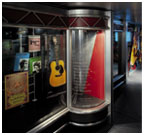December 5, 2001: On the Campus
 Get
on the Bus
Get
on the Bus
A Magical Musical Tour comes to campus
By Zach Pincus-Roth ’02
Photo: The Experience Music Project’s Electric Bus brought rock ‘n’ roll esoterica to campus. (Experience Music Project)
Bob Dylan’s harmonica and Kurt Cobain’s smashed guitar came to Princeton as part of the Electric Bus, a traveling museum set up in two blue tents and a purple truck in the parking lot next to Baker Rink for five days in October.
The Bus is an educational outreach program of the Experience Music Project in Seattle, a high-tech museum of contemporary popular music that opened in June 2000.
“We’re trying to raise awareness about the importance of music in our society,” said John Enga, the Bus’s stage manager.
The Bus’s exhibit is a bite-sized sample of the museum, focusing on songs and songwriters. The first tent contains exhibits on the origins and impact of specific popular songs of the past hundred years. For instance, a blurb explains how The Clash’s “Rock the Casbah” “portrays Middle East leaders trying to squelch their people’s right to ‘boogie.’ ” Computers show interactive video footage of artists such as Lou Reed, Carole King, and Ice-T talking about their songs.
Inside the truck, rock and roll fans can see artifacts such as Cobain’s band Nirvana’s gold album certificate for its CD Nevermind and Jimi Hendrix’s original handwritten lyrics to “Love and Confusion,” and a wide-screen television plays music videos by the featured artists. Finally, the second tent contains a classroom for songwriting lessons and a hands-on music laboratory where visitors can compose and perform music using computers, microphones, keyboards, and mixing equipment. Inside all three spaces, the exhibit’s décor is amusingly concert-like, with stainless steel trusses holding up speakers and colored lights.
The Bus travels in three trucks with an eight-member crew for three months at a time, stopping at universities across the country (Virginia Tech, North Carolina, and Duke were its next visits). Though the USG invited the Bus to come to Princeton, no money was exchanged – Microsoft, along with other sponsors and educational grants, funds the Bus’s tour.
Unfortunately, the Bus came to Princeton during midterms week.
“It’s severely impacted our reach into the student body,” Enga said. Only 200 people visited each day, although a Times of Trenton article about the Bus brought in a few families from town, and students eventually began to come as midterms finished.
In conjunction with the bus’s arrival, Eric Weisbard ’88, a WPRB alum and the senior program manager of the EMP museum in Seattle, spoke on October 24 to about 50 people in McCormick 101 on popular music since Cobain’s suicide in 1994. Weisbard’s informal, music clip-filled presentation had even American Studies Program Chair Sean Wilentz tapping his foot to songs like “Kerosene” by the indie rock band Big Black. Weisbard also spent time analyzing Mariah Carey, arguing that though no one ever says anything good about her, we should acknowledge that “Mariah Carey’s artistic yearnings are the yearnings of a lot of other people.”
In the same way, the Bus’s exhibit acknowledges music’s purely pleasurable side. One display case, for example, contrasts Public Enemy, “one of the most potent voices in the cause of ‘rap as activism,’ ” with the late 1980s’ Tone Loc, who “helped prove that rap could be fun.” Though the exhibit celebrates the social commentary of artists like Dylan, Hendrix, and Cobain, it does not ignore hit factories like Tin Pan Alley of the 1890s and the Brill Building of the 1960s. In one video, Randy Newman downplays the influence of lyrics, and an interactive station entitled “Play That Hook” reminds visitors that frequently a catchy melody is what makes a song popular.
As Weisbard put it, “There
are spaces between underground and ‘so big you burst.’ ”
![]()
Zachary Pincus-Roth ’02 is a fan of classic rock and musical theater.
Zach Pincus-Roth details one crazy week before a Triangle show, now on On the campus Online.
